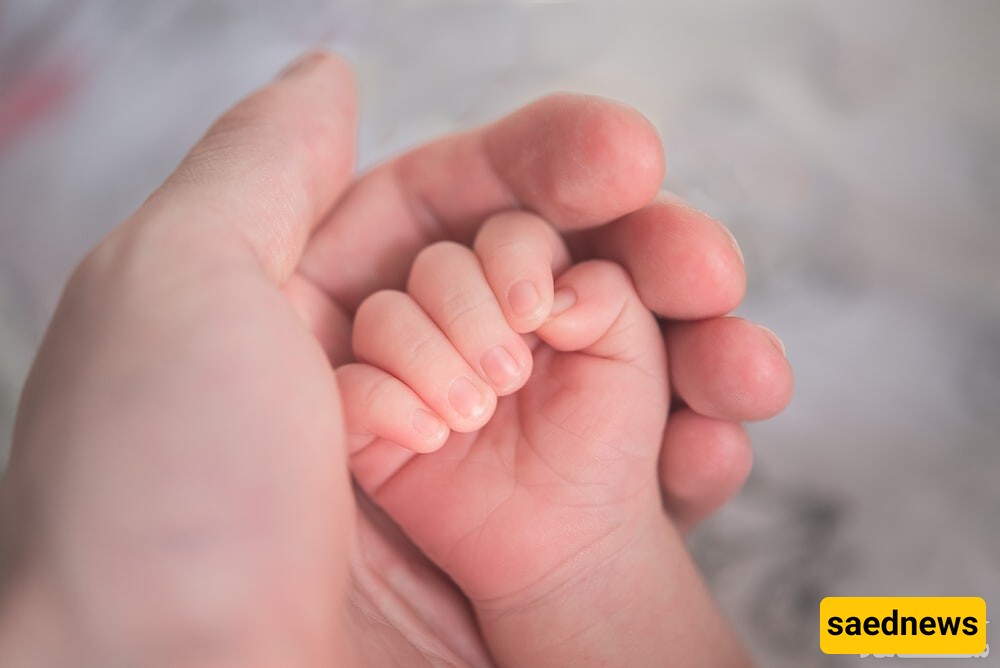The sense of touch in newborns is one of the strongest and most essential senses. It plays a vital role in helping you create an emotional bond with your baby. Touch also helps your child communicate their needs to you, interact with others, and explore their surroundings.

The sense of touch begins to form in the seventh or eighth week of pregnancy. By the time you may not even know you are pregnant or have just discovered it, the fetus already has a sense of touch. By the 11th week of pregnancy, the fetus begins to make small movements in the womb. These tiny movements mark the beginning of the baby's exploration through touching the womb and their own body. Although touch is the first and most fundamental sense in both the fetus and the newborn, it continues to develop after birth and throughout the first year of life.

You establish your first connections with your baby through touch—when you hold them, breastfeed and feed them, bathe them, soothe them, and caress them. Later, your baby will use their sense of touch to explore and evaluate the texture, material, and shape of the world around them.
Caressing the fetus during pregnancy not only enhances their intelligence but also strengthens the emotional bond between mother and baby. The fetus enjoys these gentle touches and massages. By around the 22nd week of pregnancy, when the mother can feel fetal movements, massaging the belly—especially with olive oil—not only helps prevent pregnancy stretch marks but also calms the baby and provides reassurance. However, different fetuses respond differently to touch.
Babies are born with highly sensitive skin, and some areas of their bodies, including the mouth, cheeks, face, hands, abdomen, and heels, are particularly receptive to touch. This sensitivity develops as they grow:
Newborn Stage: For a newborn, skin-to-skin contact is a vital part of emotional bonding and communication. They find comfort in being touched and may respond to touch by grasping reflexively. If you stroke their palm, they will wrap their fingers around yours tightly. Similarly, if you place an object in their palm, they will grasp it. Most reflexes fade as the baby grows. The baby's mouth is also highly sensitive and serves as another way for them to learn and explore the world. If you gently touch their cheek, they will turn toward you and use their mouth to investigate the source of the touch—this is called the rooting reflex. When placed near the breast, they instinctively use their mouth to find and latch onto the nipple.
One Month: At one month old, a baby's hands remain mostly clenched, but when open, they enjoy grasping your finger when you touch their palm. This simple action can be repeated often for enjoyment and bonding. Consider sharing these moments with the baby's father to help him also develop an emotional connection.
Two to Three Months: During activities like changing diapers or feeding, babies enjoy skin contact. They gradually respond to gentle, affectionate touches. Their tongue, lips, and mouth remain highly sensitive, and when they gnaw on a soft toy, they use these parts to explore textures. At this stage, they are unable to pick up objects on their own but enjoy having things placed in their hands. They can also begin distinguishing between hard and soft objects.
Four Months: As their muscles, particularly in their hands, grow stronger, babies start reaching for objects to touch.
Five Months: Babies begin to grasp and hold objects, sometimes using both hands. However, they still rely on their mouths to explore textures. They may also enjoy the sensation of being in water, especially splashing in the bath.
Six Months: The sense of touch improves, and babies learn to reach for and grab objects with both hands, transferring them from one hand to another. They enjoy interactive toys that respond to touch, such as those that make sounds.
Seven to Eight Months: At this stage, a baby’s spatial awareness develops alongside their sense of touch. This enables them to differentiate between flat and three-dimensional objects. They enjoy holding objects with handles or twisted shapes. Some babies may start crawling or scooting, giving them more access to explore their surroundings through touch.
Nine to Ten Months: Babies at this age often crawl and are constantly exploring new objects to touch. Parents should ensure the environment is safe, as babies still use their mouths for exploration. They enjoy picking up objects and placing them inside containers. Providing colorful toys with moving parts, such as levers, doors, or wheels, can encourage safe exploration.
Eleven to Twelve Months: By the time they reach one year old, babies explore a variety of textures, including hard, soft, cold, wet, sticky, and spongy surfaces. They rely less on their mouths for exploration and use their hands more effectively for touching and playing.
There are several ways to calm a baby using touch. If you haven’t tried them yet, you might want to start and see how they affect your baby:
Gentle Touch: A light touch is one of the best ways to soothe a fussy or crying baby. Rubbing their back gently can help them feel comforted.
Skin-to-Skin Contact: Babies enjoy being held, caressed, rocked, and carried close. This provides them with warmth, security, and familiarity.
Massage: Some babies enjoy being massaged. Regular massage can strengthen the emotional bond between parent and child. Both parents can take turns massaging the baby.
Kangaroo Care: Research has shown that skin-to-skin contact, or "kangaroo care" (holding the baby directly against the bare chest), can increase oxytocin levels, reduce crying, and improve sleep and breastfeeding. This practice benefits not only the baby but also the parents, as it helps regulate their blood pressure and hormones. Oxytocin, also known as the "love hormone," increases in both mothers and fathers after physical contact with their baby.
You can stimulate and develop your baby’s sense of touch in several ways:
Skin Contact: Massaging the baby provides essential skin-to-skin contact, promoting long-term emotional security. This is particularly beneficial for preterm babies and those born with low birth weight. By observing your baby's responses, you will learn what types of touch they enjoy most.
Playing: Play is essential for learning and development. Playing with different toys and objects can help stimulate a baby’s sense of touch. Researching age-appropriate activities can be beneficial.
Different Textures & Noisy Toys: Introducing different textures—such as smooth, rough, hard, or soft materials—can be engaging. Toys that make sounds, such as rattles, can also be exciting. Textured books, fabrics, fur, and cardboard provide various sensory experiences. As babies grow, activities like playing with sand, water, or clay can be introduced.
Placing Objects in Their Hands: At first, simply opening your baby’s hand and stroking it with different textures can help develop their sense of touch. As they grow, they will start transferring objects from one hand to another.
Touching & Playing with Food: When your baby starts eating solid foods, allow them to touch and play with their food. Though messy, this experience encourages them to try new foods and explore different textures.
This game is suitable for babies from newborns to 10 months old and helps develop hand-eye coordination and sensitivity to touch.
What You Need: Soft objects such as a silk scarf, a clean feather duster, a plush shawl, satin or velvet fabric, and a fluffy stuffed animal.
How to Play:
Lay your baby on a blanket in a warm, comfortable space. Undress them or unbutton their onesie. Introduce different textures by gently brushing each item against their skin while describing the sensation, such as “Feel this silk scarf? It’s so smooth,” or “Do you feel this teddy bear? It’s fluffy!” Let them experience textures at different speeds and intensities. As they grow, they may try to grab objects from you. Let them hold and explore them, ensuring they are clean and safe.

